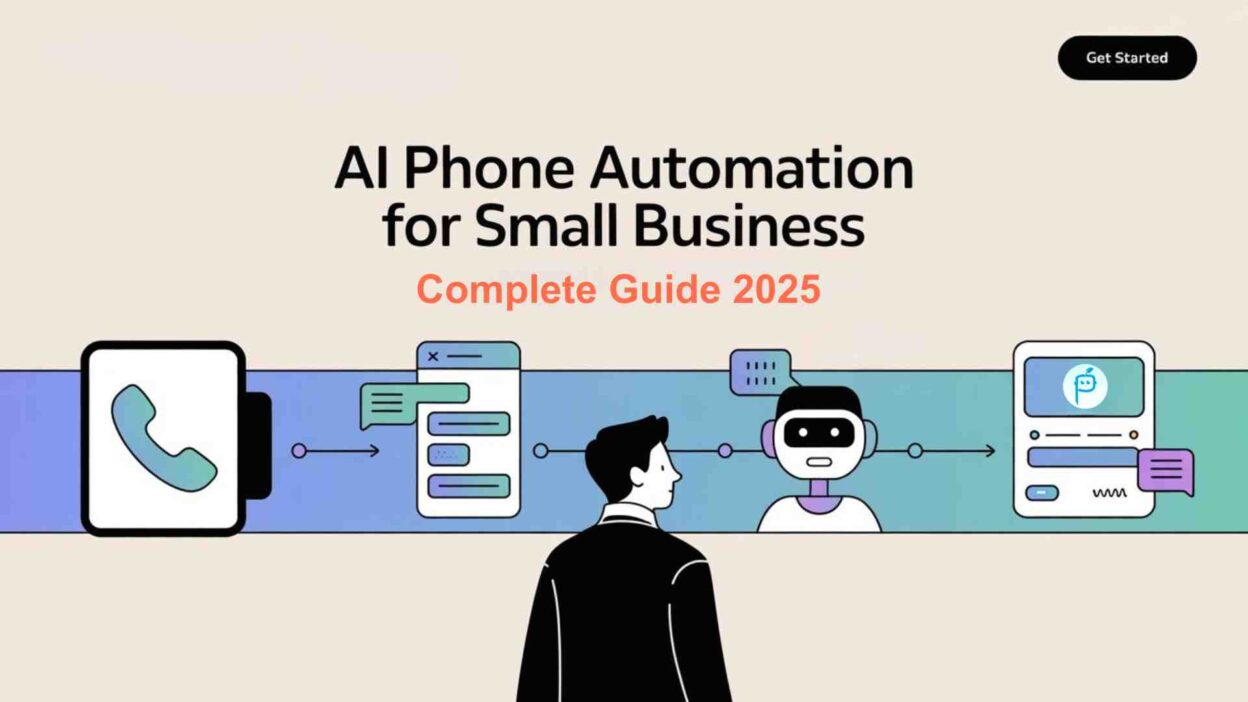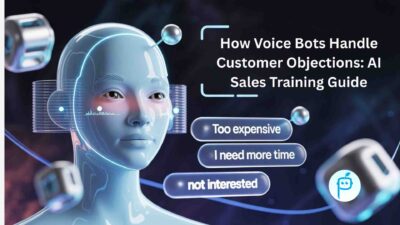TL;DR AI phone automation for small business transforms customer communication completely. Small businesses lose 27% of potential customers due to unanswered calls. Your competitors capture those lost opportunities instantly.
Table of Contents
Why Small Businesses Need Voice Bot Setup Now
Customer expectations changed dramatically in 2025. People demand instant responses. They expect 24/7 availability without exception. Manual phone handling fails these modern requirements consistently.
Small business owners juggle multiple responsibilities daily. Phone calls interrupt critical tasks repeatedly. Staff costs for dedicated receptionists strain tight budgets. After-hours calls disappear into voicemail blackholes.
Missed calls equal missed revenue directly. Each unanswered call represents lost opportunity permanently. Customers rarely call back after reaching voicemail systems. Your business bleeds potential revenue every single day.
Understanding AI Phone Automation Technology
AI phone automation uses artificial intelligence to handle phone calls automatically. The system answers calls instantly, understands speech patterns, provides accurate information, and routes calls appropriately. Modern AI systems sound remarkably human to callers.
Voice technology advanced significantly in recent years. Customers often cannot distinguish between AI and human agents during conversations. Speech recognition achieves 95%+ accuracy rates consistently. Natural language processing understands complex requests and context perfectly.
Core Technology Components
Speech Recognition Engine: Converts spoken words into text data instantly. Background noise filtering improves call quality dramatically. Multiple accent recognition handles diverse customer demographics effectively.
Natural Language Processing: Understands caller intent and conversation context. Handles complex questions and specific requests intelligently. Adapts to different speaking styles and regional dialects seamlessly.
Text-to-Speech Technology: Converts responses into natural-sounding speech instantly. Multiple voice options match brand personality perfectly. Customizable speaking pace and tone enhance customer experience.
Intelligent Call Routing: Directs calls based on predetermined business rules. Integrates with existing phone systems smoothly. Handles multiple simultaneous calls without capacity limitations.
Benefits of AI Phone Automation for Small Business
Immediate Cost Reduction
Voice bot setup eliminates receptionist salary costs completely. Average receptionist salary ranges $25,000-$35,000 annually plus benefits. AI systems cost fraction of human staff expenses long-term.
No sick days or vacation time disruptions occur. System operates continuously without breaks or downtime. Overtime costs disappear completely from payroll expenses. Holiday coverage requires no additional staffing costs.
Enhanced Customer Experience Delivery
Customers reach assistance immediately without waiting. No hold times or frustrating busy signals ever. Consistent service quality delivered every single call. Professional image maintained at all times automatically.
Multiple language support serves diverse customer bases. AI handles various customer demographics expertly. Cultural sensitivity programmed into conversation flows. Accessibility features support customers with disabilities.
Revenue Generation Opportunities
After-hours calls generate additional business automatically. Weekend and holiday availability captures more customers consistently. Lead qualification happens during every conversation systematically.
Appointment scheduling works around the clock efficiently. Service information becomes available instantly always. Upselling opportunities integrate into natural conversations. Cross-selling recommendations based on customer history.
Unlimited Business Scalability
Handle unlimited simultaneous calls without restrictions. Busy signals become history permanently. Peak periods managed effortlessly without staffing concerns. Geographic expansion simplified through cloud deployment options.
Business growth requires no additional phone staff ever. System capacity scales with growing needs automatically. Multiple location support included in most platforms. International expansion supported with multilingual capabilities.
Step-by-Step Voice Bot Setup Process
Phase 1: Strategic Planning and Requirements
Define Call Handling Objectives
List primary reasons customers contact your business daily. Identify most common questions and service requests. Document current call handling procedures thoroughly. Analyze peak calling times and volume patterns.
Create detailed call flow diagrams for every scenario. Map complete customer journey from initial contact to resolution. Include backup procedures for complex issues requiring human intervention. Plan emergency protocols for system maintenance periods.
Integration Requirements Assessment
Review existing phone system capabilities and limitations. Check CRM software compatibility and data access needs. Evaluate calendar and scheduling tools for appointment booking. Assess payment processing integration requirements for transactions.
List required data connections for customer information access. Plan real-time synchronization needs with business systems. Consider inventory management integration for product availability. Evaluate marketing automation platform connections for lead nurturing.
Phase 2: Provider Selection Process
Research AI Phone Automation Providers
Compare feature sets across multiple platforms comprehensively. Read actual user reviews and detailed case studies. Test demo systems thoroughly with realistic scenarios. Evaluate technical support quality and responsiveness levels.
Request references from similar businesses in your industry. Analyze pricing structures including hidden fees carefully. Factor in setup costs and ongoing monthly expenses. Consider scaling costs as business volume grows.
Technical Infrastructure Assessment
Check internet bandwidth requirements for optimal performance. Verify phone system compatibility with chosen platform. Review security certifications and compliance features thoroughly. Understand backup and redundancy options for business continuity.
Evaluate disaster recovery procedures and data protection measures. Assess integration complexity and implementation timeline requirements. Plan for staff training and change management processes. Consider hardware upgrade needs for older systems.
Phase 3: System Configuration and Customization
Voice Selection and Brand Alignment
Choose voice characteristics matching your brand identity perfectly. Professional services benefit from mature, authoritative voice tones. Creative businesses may prefer younger, energetic speaking styles. Test voice options with actual customers before final selection.
Record custom greetings and branded response messages. Maintain consistent brand voice across all customer interactions. Update seasonal messages and promotional announcements regularly. Consider regional accent preferences for local market appeal.
Conversation Flow Programming
Start with simple call routing logic initially. Gradually add complexity as system proves reliable consistently. Test every possible conversation path thoroughly before deployment. Program fallback options for unrecognized requests and edge cases.
Include easy transfer options to human agents when needed. Plan for system maintenance periods and backup procedures. Design graceful error recovery for technical difficulties. Implement natural conversation pauses and interruption handling.
Phase 4: Integration and Data Synchronization
CRM System Connection Setup
Sync customer databases with AI system for personalization. Enable real-time data access during active calls. Configure automatic record updates after each interaction. Set up lead capture and qualification processes systematically.
Program follow-up task creation for sales teams. Enable sales pipeline integration and opportunity tracking. Configure customer service ticket creation for complex issues. Implement customer satisfaction survey automation.
Business System Integration
Connect appointment booking systems for scheduling automation. Configure staff availability windows and booking rules. Set up automatic confirmation and reminder sequences. Enable rescheduling and cancellation handling procedures.
Integrate inventory management for product availability checks. Connect payment processing for transaction completion. Link marketing automation for lead nurturing workflows. Synchronize accounting systems for revenue tracking.
Phase 5: Testing and Deployment
Comprehensive System Testing Protocol
Test all call scenarios thoroughly including edge cases. Include unusual requests and complex interaction patterns. Verify integration functionality with all connected systems. Conduct load testing with multiple simultaneous calls.
Check system performance during peak traffic periods. Validate backup procedures work correctly during failures. Test failover systems and redundancy measures thoroughly. Verify data accuracy and synchronization across platforms.
Gradual Launch Strategy
Start with limited deployment during low-risk periods. Monitor system performance closely during initial phases. Gather feedback from early customer interactions systematically. Make necessary adjustments before full deployment rollout.
Train staff on new system capabilities and procedures. Prepare customer communication about service enhancements. Document lessons learned during implementation process. Plan for ongoing optimization and improvement cycles.
Choosing the Right AI Phone System
Essential Feature Requirements
Core Functionality Checklist
Speech recognition accuracy exceeding 95% in real-world conditions. Natural conversation capabilities handling complex dialogs. Multi-language support for diverse customer demographics. Integration compatibility with existing business tools.
Scalable capacity supporting business growth without limitations. Reliable uptime guarantees with minimal service interruptions. Advanced analytics and reporting for performance monitoring. Customizable voice options matching brand personality requirements.
Advanced Capability Considerations
Sentiment analysis for customer satisfaction monitoring continuously. Real-time analytics dashboard for immediate insights. Customizable conversation flows for industry-specific needs. Advanced call routing based on customer history and preferences.
Automated follow-up capabilities for lead nurturing sequences. Marketing automation integration for campaign management. Social media integration for omnichannel customer experience. Mobile app connectivity for remote management capabilities.
Investment and Pricing Analysis
Per-Minute Pricing Models
Pay only for actual usage without wasted capacity costs. Predictable expenses based on call volume patterns. Ideal for businesses with varying seasonal call patterns. Typical rates range $0.05-$0.15 per minute depending on features.
Volume discounts available for high-usage businesses automatically. No upfront capacity planning required for growth. Scales perfectly with business expansion naturally. International calling rates vary by destination country.
Monthly Subscription Options
Fixed monthly costs regardless of actual usage volume. Unlimited calling within predetermined plan limits. Predictable budgeting for consistent call volume businesses. Plans typically range $50-$500 monthly depending on features.
Feature availability varies significantly between subscription tiers. Overage charges apply when exceeding plan limits. Annual commitments often provide significant cost savings. Enterprise plans include dedicated support and custom features.
Vendor Evaluation Process
Technical Capabilities Assessment
Request detailed technical specifications and architecture documentation. Test systems with actual business use cases thoroughly. Evaluate integration complexity and implementation timeline requirements. Review security certifications and regulatory compliance measures.
Check disaster recovery procedures and data backup systems. Assess scalability limitations and growth accommodation capabilities. Evaluate API quality and developer documentation completeness. Test system performance under various load conditions.
Service and Support Quality
Evaluate technical support responsiveness during business hours. Review training and onboarding process comprehensiveness. Check availability of dedicated account management services. Assess vendor financial stability and market track record.
Research customer references and industry case studies thoroughly. Read online reviews and community forum discussions. Evaluate long-term partnership potential and vendor roadmap. Consider geographic support coverage for international businesses.
Implementation Success Strategies
Overcoming Technical Challenges
Legacy System Integration
Older phone systems may require hardware upgrades for compatibility. VoIP systems generally integrate more easily than traditional landlines. Budget additional costs for necessary equipment and installation services. Plan for potential service interruptions during upgrade processes.
Consider phased migration approaches for complex environments. Maintain backup systems during transition periods. Test integration thoroughly before cutting over production traffic. Document configuration changes for future reference and troubleshooting.
Data Quality and Synchronization
Customer databases need cleaning and preparation before integration. Real-time synchronization presents technical challenges requiring expertise. Allocate sufficient time for data mapping and validation processes. Consider hiring integration specialists for complex requirements.
Plan for data migration and testing phases carefully. Implement data quality monitoring and correction procedures. Establish data governance policies for ongoing maintenance. Create backup and recovery procedures for data protection.
Managing Organizational Change
Staff Training and Adoption
Employees may fear job displacement from automation technology. Comprehensive training programs address skill gaps and concerns. Highlight how AI enhances rather than replaces human capabilities. Provide ongoing support during transition and adaptation periods.
Document new workflows and procedures clearly for reference. Adjust processes based on real-world experience and feedback. Create performance metrics for measuring adoption success. Recognize and reward early adopters and champions.
Customer Acceptance and Satisfaction
Some customers prefer human interaction over automated systems. Communicate AI benefits and capabilities to customer base. Provide easy options for human assistance when requested. Continuously improve system performance based on customer feedback.
Monitor customer satisfaction scores closely during implementation. Address complaints and concerns promptly and effectively. Implement improvements based on user experience data regularly. Maintain high service quality standards consistently across channels.
Cost Analysis and ROI Expectations
Investment Breakdown Analysis
Initial Setup Investment
AI platform subscription fees typically range $100-$1,000 monthly depending on features. Professional integration services cost $2,000-$10,000 based on complexity requirements. Hardware upgrades range $500-$5,000 for most small business environments.
Training and implementation support adds $1,000-$5,000 to total costs. Testing and optimization phases require 1-3 months time commitment. Budget additional 20% contingency for unexpected expenses and requirements. Annual contracts often provide significant cost savings over monthly billing.
Ongoing Operational Expenses
Monthly platform fees continue throughout system usage period. Variable per-minute charges depend on actual call volume. Maintenance and support contracts typically cost 10-20% of system value annually.
Staff training and system updates require periodic investment. Integration maintenance may need ongoing technical support services. Plan for annual feature upgrades and platform improvements. Consider inflation adjustments for multi-year planning purposes.
Revenue Impact Measurement
Direct Cost Savings Quantification
Receptionist salary elimination saves $25,000-$35,000 annually plus benefits. Reduced overtime and temporary staff costs during peak periods. Lower training expenses and employee turnover costs. Decreased telecommunication expenses through system efficiency.
Eliminated missed call losses typically recover 15-30% additional revenue monthly. After-hours call capture adds 10-20% new business opportunities. Improved customer service reduces churn rates by 5-15% annually. Professional image enhancement attracts higher-value customer segments.
Revenue Enhancement Opportunities
Automated upselling increases average transaction values by 10-25%. Lead qualification improves sales conversion rates significantly. Appointment scheduling reduces no-shows and cancellations substantially. Extended service hours capture previously missed business opportunities.
Consistent service quality enhances customer satisfaction scores measurably. Professional image attracts premium customers willing to pay higher prices. Efficient call handling increases capacity for revenue-generating activities. Data collection enables targeted marketing and personalization strategies.
Break-Even Timeline Analysis
Most small businesses achieve break-even within 6-12 months of implementation. High-call-volume businesses recover investment costs faster than low-volume operations. Service-based businesses typically see quicker returns than product-focused companies.
Monthly operational savings of $2,000-$4,000 common for busy small businesses. Additional revenue from captured calls accelerates payback period significantly. Improved customer retention provides long-term value beyond initial ROI calculations. Compound benefits increase over time as system optimization improves.
Future-Proofing Your Investment
Technology Evolution Planning
AI Advancement Integration
Voice technology capabilities improve rapidly each year with new features. Plan for regular system upgrades and enhancement implementations. Stay informed about industry developments and emerging capabilities. Evaluate new features as they become available commercially.
Consider advanced options like emotion recognition and predictive analytics. Plan for integration with emerging technologies like virtual reality. Assess artificial general intelligence impacts on customer service. Prepare for voice-first interaction paradigm shifts.
Business Growth Accommodation
Choose systems scaling with business expansion automatically. Plan for increased call volumes and interaction complexity. Consider multi-location deployment requirements for geographic growth. Evaluate advanced features as business needs evolve naturally.
Plan for integration with new business systems and platforms. Consider expanded language and service options for market expansion. Assess international deployment requirements for global growth. Prepare for industry-specific compliance and regulatory changes.
Competitive Advantage Maintenance
Market Differentiation Strategies
Use AI capabilities to differentiate from traditional competitors significantly. Leverage advanced features for superior customer service delivery. Plan for unique applications specific to your industry vertical. Identify opportunities for competitive advantage through innovation.
Monitor competitor implementations and capability developments regularly. Benchmark performance against industry standards and best practices. Invest in capabilities providing lasting differentiation from competitors. Stay ahead of market trends and customer expectation evolution.
Innovation and Continuous Improvement
Implement regular performance reviews and optimization cycles. Gather customer feedback actively for system enhancement opportunities. Track industry developments and emerging best practices. Plan for technology refresh cycles and platform migrations.
Maintain focus on customer experience throughout system evolution. Balance automation efficiency with human touch requirements. Consider emerging channels and communication preferences. Prepare for generational shifts in technology comfort levels.
Read More: Best Open Source Text To Speech Software Local No Internet 2025
Conclusion

AI phone automation for small business delivers transformative results when implemented strategically and executed properly. The technology eliminates missed call revenue losses, reduces operational costs significantly, and enhances customer satisfaction measurably.
Voice bot setup requires careful planning, thorough research, and systematic execution. Choose providers with proven track records, comprehensive support services, and strong technical capabilities. Start with basic functionality and expand capabilities gradually as experience and confidence grow.
The financial investment pays for itself within 6-12 months for most small businesses through direct cost savings and revenue enhancement. Professional image improvement attracts higher-value customers consistently and creates lasting competitive advantages in the marketplace.
Success depends on proper system configuration, comprehensive staff training, and ongoing performance optimization. Monitor key performance metrics closely and adjust strategies based on real-world results and customer feedback. Maintain unwavering focus on customer experience throughout implementation and operation.
AI phone automation for small business represents essential technology for competitive success in 2025 and beyond. Early adopters gain significant advantages over competitors using traditional phone handling methods. The question facing small business owners is not whether to implement AI phone automation, but how quickly they can deploy it effectively to capture market opportunities and enhance customer relationships.






[…] Multi-location phone automation ensures brand protection while enabling franchise growth and local market success. […]